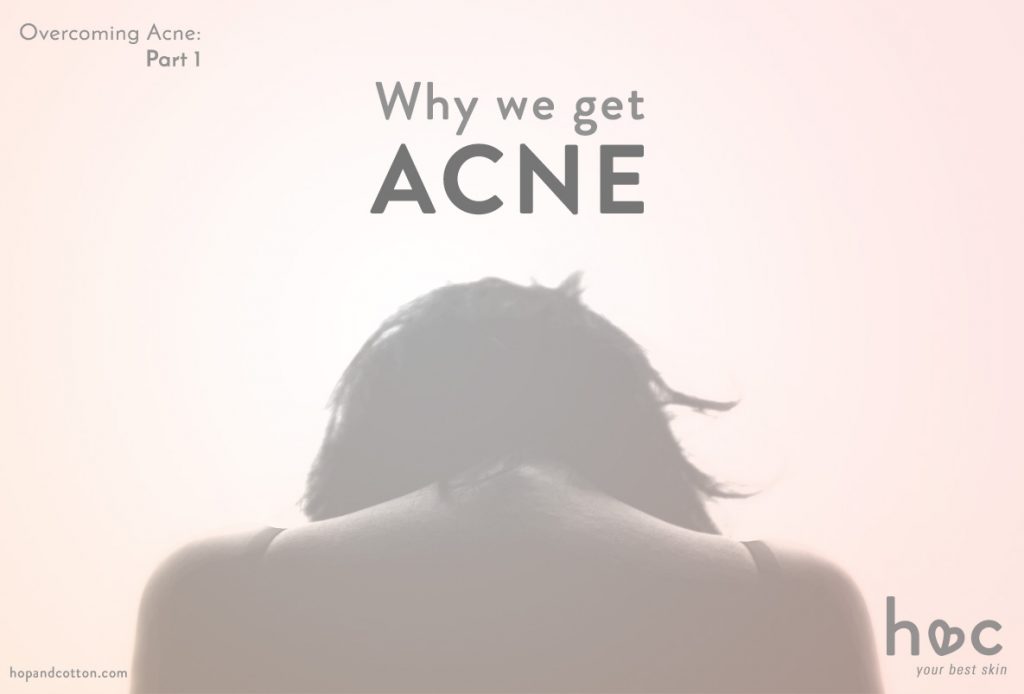Overcoming Acne 1: Why we get acne

Acne might be a skin disorder, but it causes more than superficial damage.
Other than the obvious, it inflicts self-consciousness, anxiety and distress. It made me feel like a stranger in my own skin.
The first real step to overcoming acne is actually not to find the best zit-zapping product, but to understand why it is happening. Going to the root of the problem allows us to identify what is causing our acne, which is half the battle won.
What should be happening and what goes wrong in acne
Our skin cells follow a cycle that starts from the bottom and moves upwards towards the skin surface. Eventually they shed off. This is how skin cells turnover.
Normally, the skin cells in pores build up and shed off by themselves. Our skin’s natural oil (sebum) produced in the pore helps push these cells out onto the skin surface. Sebum levels are controlled by our hormones.
In acneic skin, there is increased sebum produced (due to hormones) and build-up of cells within the pores. With more in numbers, the skin cells become sticky and get stuck within the pore. This blocked pore, also known as a comedone, leads to the start of all types of acne.
Non-inflammatory comedones
You might have heard that acne is an inflammatory skin condition. But not all comedones are inflamed. The non-inflammed types are commonly known as blackheads or whiteheads.
- Open comedone (blackhead) – open; exposed to air, appearing black due to oxidation.
- Closed comedone (whitehead) – closed; unexposed to air.
Inflammatory comedones
Inflammatory acne is commonly associated with a type of bacteria called Propionibacterium acnes. They normally exist on our skins without causing us problems.
However, when sebum gets trapped within the clogged pore, the bacteria feeds on the sebum and multiplies quickly and exponentially.
Eventually, our body will detect the presence of this foreign invader, and will try to get rid of it.
Lots of white blood cells will start heading towards the site to try to remove this foreign invader. It will start to swell and turn red, sometimes with pus. This is inflammation.
There are different types of inflamed comedones of varying severity.
- Papules – most commonly referred to as pimples or spots, are usually pink, small and raised.
- Pastules – larger with more swelling, usually containing pus.
- Nodules and cysts – most serious forms of comedones that are larger, deeper and with a lot more pus.
In rare cases, inflammatory acne can be caused by some types of yeast called Malassezia. They also occur naturally on skin and thrive on sebum and sweat.
Irritation and inflammation
Inflammation may not always be caused by bacteria or yeast.
It can sometimes be due by irritation. Irritants can cause lumps or bumps that resemble acne. Irritants can be physical (from rubbing or tight clothings) or chemical (e.g. natural/synthetic fragrances).
Any ingredient has the potential to cause irritation for anyone, although some ingredients are known to be worse than the others.
Acne and cosmetic products
Acne can sometimes be caused when we use incompatible products for our skin.
Some possibilities are
- Cleanser that does not rinse off completely – oil, balm or cream cleaners
- Abrasive scrub that is too harsh, causing ‘breakouts’ – fruit shells, microdermabrasion-type particles
- Moisturiser or serum too rich for your skin type – thick-textured or high in certain plant oils

Diet and acne
In a nutshell, the exact link between diet and acne is still unknown. There are implications that certain foods can cause acne, but more studies are needed for conclusive findings. That being said, as skin is our largest organ of our body, it makes sense to have a balanced diet with plenty of fresh produce and water.
What is causing your acne?
Except for extreme cases, acne is usually caused from a combination of lifestyle factors or product choices. You might be experiencing hormonal changes, regularly rubbing face with cleansing cloth, using dirty pillow cases or mobile phones full of bacteria.
Or it could be that you do not actually have acne and that your favourite rose-scented night cream is causing irritation.
Now that you have identified what is causing your acne, let’s find out which ingredients/products are best for treating them in Part 2.
References:
Picardo M et al., Sebaceous Gland Lipids, Dermato-Enocrinology 2009, 1:2, 68-71
Thiboutot D.M, Smith K.R, Sebaceous gland lipids: friend or foe?, Journal of Lipid Research 2008, Vol 49, 271-281
Fulton, Comedogenicity and irritancy of commonly used ingredients in skin care products, J. Soc. Cosmet. Chem., 40, 321-333 (November/December 1989)
Karen Mckoy, MD, MPH, Acne Vulgaris, from MSD Manual, March 2015, www.msdmanuals.com/en-au/professional/dermatologic-disorders/acne-and-related-disorders/acne-vulgaris
Richard M. Rubenstein et al., Malassezia (Pityrosporum) Follicullitis, J Clin Aesthet Dermatol. 2014 Mar; 7(3): 37–41


